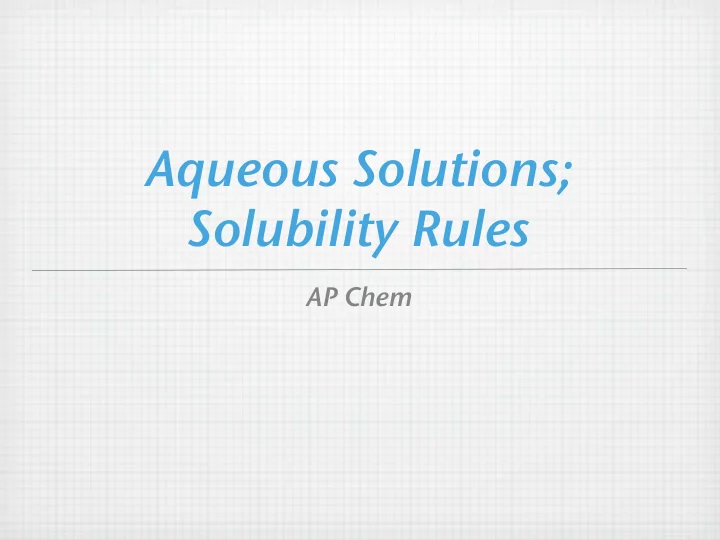

Aqueous Solutions; Solubility Rules AP Chem
General Properties Recall: Homogeneous mixture of 2 or more pure substances Aqueous Solutions of interest because water is polar, can dissolve many polar and ionic substances Hydration is process in which H 2 O molecules surround an ion or molecule to dissolve it.
Solution Formation Ions undergo hydration when formed Each ion surrounded by H 2 O molecules with oppositely charged end of dipole oriented toward it Stabilizes ions & prevents recombination
Electrolytes Soluble ionic compounds, dissociate when dissolved: H 2 O A x B y (s) xA n+ (aq) + yB m– (aq), where x(n+) + y(m–) = 0 ⎯ ⎯ ⎯ → H 2 O e.g. Na 3 PO 4 (s) 3Na + (aq) + PO 43– (aq) ⎯ ⎯ ⎯ → Ions in solution provide mobile charges to conduct electricity Stronger solutions, higher solubility give higher conductivity Ionic compounds also conduct when molten (mobile charges) Strong Acids & Bases dissociate/ionize completely, so are strong electrolytes H 2 O e.g. HCl(g) H + (aq) + Cl – (aq) ⎯ ⎯ ⎯ → Weak Acids & Bases partially ionize, so are weak electrolytes e.g. HF (aq) ⇌ H + (aq) + F – (aq) Molecular substances (e.g. sugar) do not ionize, no conductivity—Nonelectrolytes
Rules to determine electrolytes and non-electrolytes All soluble ionics are strong electrolytes (including ionic bases–e.g. NaOH, KOH) All molecular substances (covalent compounds) are non- electrolytes except for acids and NH 3 , R 2 NH All strong acids are strong electrolytes HCl, HBr, HI, HNO 3 , H 2 SO 4 , HClO 4 **MEMORIZE! Dissociate completely in water All other acids are weak electrolytes Some common weak acids: HF, HNO 2 , H 3 PO 4 , CH 3 COOH (acetic acid) Dissociate only slightly in water Ammonia (NH 3 ) is a weak electrolyte (weak base) MEMORIZE
Precipitation Reactions When two solutions are brought together, an insoluble combination of cation-anion may form (remember double replacement!) Insoluble compound precipitates from solution. Predict product based on solubility rules
Solubility Rules Always soluble: alkali metal ions (Li + , Na + , K + , Rb + , Cs + ), NH 4+ , NO 3– , ClO 3– , ClO 4– , CH 3 COO – (C 2 H 3 O 2– ) Generally soluble: Cl – , Br – , I – Soluble except Ag + , Pb 2+ ,Hg 22+ (CuI 2 insol.) F – Soluble except Ca 2+ , Sr 2+ , Ba 2+ , Pb 2+ , Mg 2+ SO 42– Soluble except Ca 2+ , Sr 2+ , Ba 2+ , Pb 2+ , Hg 22+ Generally insoluble: O 2– , OH – Insoluble except alkali metals and NH 4+ Somewhat soluble Ca 2+ , Sr 2+ , Ba 2+ CO 32– , PO 43– , S 2– , SO 32– , C 2 O 42– , CrO 42– Insoluble except alkali metals and NH 4+
Solubility Rules II Exceptions have common trends: Ca, Ba, Sr often exceptions (i.e. SO 42– , OH – ) Ag + , Pb 2+ , Hg 22+ always insoluble unless with always soluble anion Most anions always insoluble unless with always soluble cation Examples: Are the following compounds soluble or insoluble? K 2 SO 4 ; AgNO 3 ; AgCl, K 2 S, BaSO 4 , CaCO 3 For AP exam, need to know Na + , K + , NO 3– In double-replacement reactions, the there will always be one product containing at least one of these ions—the other will be insoluble
Recommend
More recommend